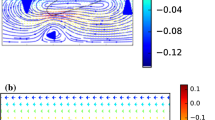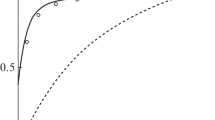Abstract
Viscous shearing is examined as a mechanism by which turbulent flows can cause cellular damage. The use of Reynolds stress as an indicator of hemolysis is considered, and an alternative measure based on viscous dissipation is proposed. It is shown that under simple flow conditions the Reynolds stresses can be related to viscous dissipation. Data from the literature show that the instantaneous viscous shear stress at which hemolysis occurs is similar to the shear stress thresholds obtained from laminar flow studies. Also, the Kolmogorov length scales for most of the turbulent hemolysis studies are similar to the size of a red blood cell. These observations indicate that, for the jet and couette experiments examined, viscous shearing is an important mechanism in the destruction of erythrocytes by turbulence. However, pressure fluctuations may also contribute to damage for these cells and for cells of similar or larger size.
Similar content being viewed by others
References
Bacher, P. P., and M. C. Williams, Hemolysis in capillary flow.Lab. Clin. Med. 76:485–496, 1970.
Baldwin, J. T., S. Deutsch, H. L. Petrie, and J. M. Tarbell. Determination of principal Reynolds stresses in pulsatile flows after elliptical filtering of discrete velocity measurements.J. Biomech. Eng. 115:396–403, 1993.
Blackshear, P. L., and G. L. Blackshear. Mechanical Hemolysis. In: Handbook of Bioengineering, edited by R. I. Skalak, C. Shu. New York: McGraw-Hill, Inc., 1987, pp. 15.1–15.19.
Blackshear, P. L., F. D. Dorman, J. H. Steinbach, E. J. Maybach, A. Singh, and R. E. Collingham. Shear wall interaction and hemolysis.Trans. Am. Soc. Artif. Intern. Organs 12:113–120, 1966.
Caro, C. G., T. J. Pedley, R. C. Schroter, and W. A. Seed. The Mechanics of the Circulation. Oxford: Oxford University Press, 1978, 527 pp.
Chew, Y. T., H. T. Low, C. N. Lee, and S. S. Kwa. Laser anemometry measurements of steady flow past aortic valve prostheses.J. Biomech. Eng. 115:290–298, 1993.
Clark, C. Turbulent velocity measurements in a model of aortic stenosis.J. Biomech. 9:677–687, 1976.
Forstrom, R. J. A new measure of erythrocyte membrane strength: the jet fragility test. Ph.D. Thesis, University of Minnesota, Minneapolis, MN, 1969.
Giersiepen, M., U. Krause, E. Knott, H. Reul, and G. Rau. Velocity and shear stress distribution downstream of mechanical heart valves in pulsatile flow.Int. J. Artif. Organs 12:261–269, 1989.
Giersiepen, M., L. J. Wurzinger, R. Opitz, and H. Reul. Estimation of shear stress-related blood damage in heart valve prostheses—in vitro comparison of 25 aortic valves.Int. J. Artif. Organs 13:300–306, 1990.
Hanle, D. D., E. C. Harrison, A. P. Yoganathan, and W. H. Corcoran, Turbulence downstream from the Ionescu-Shiley bioprosthesis in steady and pulsatile flow.Med. Biol. Eng. Comput. 25:645–649, 1987.
Hinze, J. O. Fundamentals of the hydrodynamic mechanism of splitting in dispersion processes.AICHE J. 1:289–295, 1955.
Hinze, J. O. Turbulence. New York: McGraw-Hill, 1975, 790 pp.
Jones, S. A., and A. Fronek. Analysis of break frequencies downstream of a constriction in a circular tube.J. Biomech. 20:319–327, 1987.
Keshaviah, P. R. Hemolysis in the accelerated flow region of an abrupt contraction. Ph.D. Thesis, University of Minnesota, Minneapolis, MN, 1970.
Leverett, L. B., J. D. Hellums, C. P. Alfrey, and E. C. Lynch. Red blood cell damage by shear stress.Biophys. J. 12:257–273, 1972.
Meneveau, C., and K. R. Sreenivasan. The multifractal nature of turbulent energy dissipation.J. Fluid Mech. 224: 429–484, 1991.
Niimi, H., and M. Sugihara. Cyclic loading on the red cell membrane in a shear flow: a possible cause of hemolysis.J. Biomech. Eng. 107:91–95, 1985.
Nygaard, H., M. Giersiepens, J. M. Hasenkam, H. Reul, P. K. Paulsen, P. E. Rovsing, and D. Westphal. Two-dimensional color-mapping of turbulent shear stress distribution downstream of two aortic bioprosthetic valvesin vitro.J. Biomech. 25:429–440, 1992.
Pedley, T. J. Pulmonary fluid dynamics.Ann. Rev. Fluid Mech. 9:229–274, 1977.
Rooney, J. A. Hemolysis near an ultrasonically pulsating gas bubble.Science 169:869–871, 1970.
Sallam, A. M. An investigation of the effect of Reynolds shear stress on red blood cell hemolysis. Ph.D. Thesis, University of Houston, Houston, TX, 1982.
Sallam, A. M., and N. H. C. Hwang, Human red cell hemolysis in a turbulent shear flow: contribution of Reynolds shear stresses.Biorheology 21:783–797, 1984.
Schima, H., M. R. Müller, S. Tsangaris, G. Gheisder, C. Schlusche, U. Losert, H. Thoma, and E. Wolner. Mechanical blood traumatization by tubing and throttles inin-vitro pump tests: experimental results and implications for hemolysis theory.Artif. Organs 17:164–170, 1993.
Schoephoerster, R. T., and K. B. Chandran. Velocity and turbulence measurements past mitral valve prostheses in a model left ventricle.J. Biomech. 24:549–562, 1991.
Stein, P. D., F. J. Walburn, and H. N. Sabbah. Turbulent stresses in the region of aortic and pulmonary valves.J. Biomech. Eng. 104:238–244, 1982.
Sutera, S. P., and J. H. Joist. Haematological effects of turbulent blood flow. In: Thrombosis, Embolism and Bleeding, edited by E. G. Butchart and E. Bodnar. London: ICR Publishers, 1992, pp. 149–159.
Sutera, S. P., and M. H. Mehrjardi. Deformation and fragmentation of human red blood cells in turbulent shear flow.Biophys. J. 15:1–10, 1975.
Tennekes, H., and J. L. Lumley. A First Course in Turbulence. Cambridge, MA: The MIT Press, 1972, 300 pp.
Townsend, A. A. The Structure of Turbulent Shear Flow. Cambridge: Cambridge University Press, 1976, 429 pp.
White, F. M. Viscous Fluid Flow. New York: McGraw-Hill, 1974, 725 pp.
Williams, A. R., D. E. Hughes, and W. L. Nyborg. Hemolysis near a transversely oscillating wire.Science 169: 871–873, 1970.
Woo, Y-R, and A. P. Yoganathan. Two-component laser Doppler anemometer for measurement of velocity and turbulent shear stress near prosthetic heart valves.Med. Instrumen. 19:224–231, 1985.
Wurzinger, L. J., R. Opitz, P. Blasberg, and H. Schmid-Schönbein. Platelet and coagulation parameters following millisecond exposure to laminar shear stress.Thrombosis Haemostasis 54:381–386, 1985.
Author information
Authors and Affiliations
Rights and permissions
About this article
Cite this article
Jones, S.A. A relationship between reynolds stresses and viscous dissipation: Implications to red cell damage. Ann Biomed Eng 23, 21–28 (1995). https://doi.org/10.1007/BF02368297
Received:
Revised:
Accepted:
Issue Date:
DOI: https://doi.org/10.1007/BF02368297




